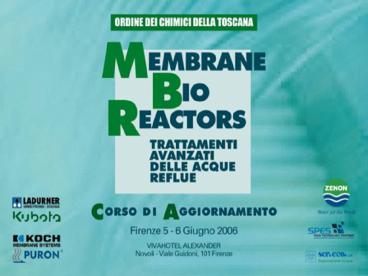Modelli matematici applicati ai processi di filtrazione a membrana - PowerPoint PPT Presentation
1 / 23
Title:
Modelli matematici applicati ai processi di filtrazione a membrana
Description:
... (Membrane) Point separation (no volume) No biological processes Complete retention of X Partial retention of colloidal fraction Modelling of a lab-scale ... – PowerPoint PPT presentation
Number of Views:131
Avg rating:3.0/5.0
Title: Modelli matematici applicati ai processi di filtrazione a membrana
1
(No Transcript)
2
Modelli matematici applicati ai processi di
filtrazione a membrana Mathematical modelling
of MBR system
Biomath, Ghent University, Belgium 06-06-2006 Tao
Jiang
3
Overview of the presentation
- Modelling the biological performance of MBR
- Modelling of MBR fouling
4
Biological difference of MBR and TAS
- Complete retention of solids and partial
retention of colloidal/macromolecular fraction - Operational parameters
- Long SRT
- Short HRT
5
Colloidal fraction in MBR
- Colloidal 0.001 µm - 1µm
- MBR membrane pore size 0.03-0.4 µm
- non-settable flocs in TAS lt 5-10 µm
- Additional removal of solids by MBR
- Small flocs (0.45-10 µm)
- Partial retention of colloids
(pore size - 0.45µm)
6
Colloidal concentration in MBR sludge
- TAS Effluent 30-60 mg/L
- MBR sludge (lt0.45µm) 50-200 mg/L
- MBR effluent (ltpore size) 5-20 mg/L
- Membrane retention 70-95
7
Colloidal fraction is S or X?
- By size
- Colloidal fraction lt 0.45 µm ? S
- By retention
- 70-90 retention ? X
- By biological degradation
- Slow biodegradable ? X
8
Colloidal fraction is X
- Colloidal fraction is X, although smaller than
0.45 µm - No significant error in TSS measurement, if the
colloidal fraction is missing (CODColltltCODTSS)
9
Influence of long SRT and short HRT
- High MLSS concentration
- MLSSSRT/HRT..
- Increased sensitivity of X (advantage of
calibration) - Inert particulate COD build up in MBR
- XI SRT/HRTXI,in
- Careful wastewater characterization
- Low active biomass fraction
10
Membrane model
- Simple option (BNR study)
- Point settler and include the colloidal fraction
into X - Complete option (membrane fouling study)
- Define new variable S_SMP (X)
- Define retention of S_SMP by membrane
11
Modelling of settler vs. membrane
- TAS (settler)
- Difficulty in calibrating settling model
- Possible biological processes in settlers
- MBR (Membrane)
- Point separation (no volume)
- No biological processes
- Complete retention of X
- Partial retention of colloidal fraction
12
Modelling of a lab-scale MBR
Parameter /variable Reference values
Influent rate 108 L/day
Aerobic 17 min
Anoxic mixing 11 min
Anoxic recirculation 12 min
SRT 17 days
HRT 6.4 hr
MLSS 7 g/L
Filtration flux 31.8 L/(m2h)
13
WEST Configuration
14
WEST Experimentation
15
Simulation results - Particulate
16
Simulation results - effluent
17
Simulation results - user defined
18
Objective of modelling MBR fouling
- Prediction of membrane fouling (TMP vs t)
- Facilitate integrated design, upgrading,
operation - Cost reduction
19
Influence of biology on fouling
- Feed to membrane is activated sludge
- The composition of activated sludge is
determined by the influent and operation of
biological process - How biology influence fouling
- What is the main foulant?
- Influence of MLSS, SRT, HRT, DO?
20
Foulant in MBRs
- The main foulant in MBRs is up to the influent
composition, design and operation - Particulate and colloidal can be the main
foulant - Colloidal fouling is getting more attention
(soluble microbial products)
21
Steps in the modelling of fouling
- Identify the main foulant
- Quantify the amount of foulant and their fouling
potential - Estimate the deposit rate of foulant on/in the
membrane - Predict additional resistance due to the foulant
- Estimate the reversibility of foulant by
backwashing and chemical cleaning
22
conclusion
23
- Modelling the biolgical performance of MBR is
simpler than TAS - Modelling of MBR fouling, especially fouling
prediction is extremely difficult and pre-mature































